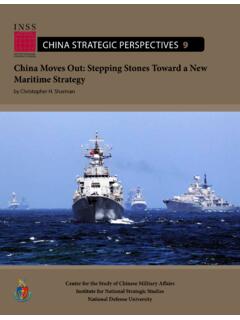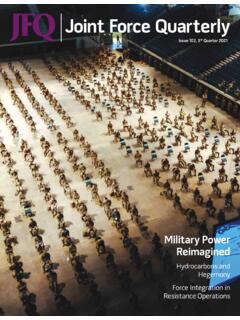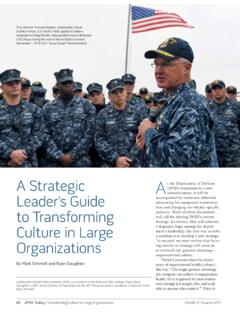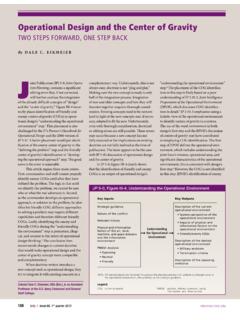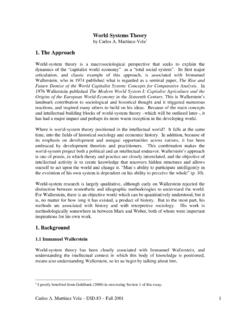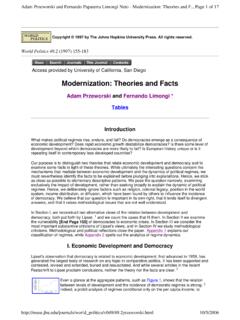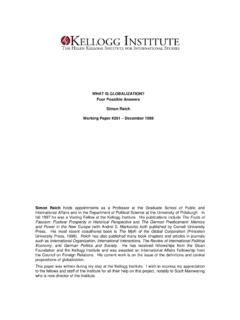Transcription of Minds at War: China’s Pursuit of Military Advantage ...
1 PRISM 8, NO. 3 FE ATURES | 83 Minds at WarChina s Pursuit of Military Advantage through Cognitive Science and Biotechnology By Elsa B. KaniaThe United States is starting to confront unprecedented challenges to the Military and technological superiority that it has enjoyed in recent history. The People s Republic of China (PRC) is emerging as a powerhouse across a range of emerging technologies, and Chinese leaders recognize today s tech-nological revolution as a critical, even historic, opportunity to achieve strategic As Chairman of the Central Military Commission (CMC) and Commander-in-Chief of the CMC Joint Operations Center, Chinese Communist Party (CCP) General Secretary Xi Jinping has highlighted the importance of Military innovation to keep pace with the times ( ) and adapt to the global revolution in Military Indeed, Xi has declared, In circumstances of increasingly intense global Military competition, only the innovators win.
2 3 Responding to this directive and imperative, the Chinese People s Liberation Army (PLA) has been actively exploring a range of new theories, capabilities, and technologies that are believed to be critical to future operational The PLA is looking to improve its capacity to leverage aca-demic and commercial developments in the process through China s national strategy of Military -civil fusion ( ).5 In particular, Chinese innovation is poised to pursue synergies among brain science, artificial intelligence (AI), and biotechnology that may have far-reaching implications for its future Military power and aggregate national competitiveness. Chinese Military leaders appear to believe that such emerg-ing technologies will be inevitably weaponized, often pointing to a quotation by Engels: Once technological advancements can be used for Military purposes and have been used for Military purposes, they very immedi-ately and almost necessarily, often violating the commander s will, cause changes or even transformations in the styles of warfare.
3 6 The PLA intends to achieve an operational Advantage through seizing the initiative in the course of this transformation. Chinese Military Innovation in the New EraChinese Military scientists and strategists have often been animated in their thinking by concern with the progression of the ongoing revolution in Military affairs (RMA) that is believed to be catalyzed by today s technological The PLA has closely examined the Military s approach to warfare, applying Ms. Elsa B. Kania is an Adjunct Senior Fellow with the Technology and National Security Program at the Center for a New American Security. Her views are her own. 84 | FE ATURES PRISM 8, NO. 3 KANIA lessons learned to its own Military modernization in seeking to catch up, while also looking for opportu-nities to pursue asymmetric capabilities or attempt to achieve a first-mover Advantage to overtake this powerful adversary ( ).
4 Since the 1990s, Chinese Military modernization has particularly concentrated on pursuing a strategy of informati-zation ( ).8 Through this agenda, the PLA has developed an array of command, control, commu-nications, computers, intelligence, surveillance, and reconnaissance (C4 ISR) systems and concentrated on advancing capabilities for information operations ( ), including cyber warfare, electronic war-fare, and psychological , PLA strategists anticipate a new style of warfare is on the horizon, as the charac-ter of conf lict evolves from informatized toward intelligentized ( ) warfare, in which AI, along with a range of technologies, is changing the form of According to Lt.
5 Gen. Liu Guozhi ( ), Director of the Central Military Commission Science and Technology Commission, AI will accelerate the process of Military trans-formation, ultimately leading to a profound Revolution in Military Affairs .. The combination of artificial intelligence and human intelligence can achieve the optimum, and human-machine hybrid intelligence will be the highest form of future intelligence. 11 This striking statement highlights the PLA s interest at the highest levels in the notion of hybrid intelligence ( ), a concept that implies a blending of human and machine intelligence, including through leveraging insights from brain science and such techniques as the use of brain-computer This concept is not merely abstract but is starting to be realized through new programs, including projects intended to promote human performance enhance-ment.
6 Future intelligentized operations ( ) are expected to involve prominent employment of intelligent autonomy ( ) in weapons systems under conditions of multi-domain integra-tion ( ) with command exercised through brain-machine integration, enabled by cloud Chinese Military scientists and strategists expect that this revolution in warfare will also demand transformation of the human element of warfare, which may require seeking command of the brain and biological sciences. Reforming for InnovationChina s Military reforms have elevated the impor-tance of innovation in ways that could contribute to the PLA s ability to overcome prior difficulties. In this new era of Chinese Military power, the PLA is seeking to reorient toward a model that lever-ages science and technology as core enablers of combat Pursuant to the reforms, the PLA has created the CMC Steering Committee on Military Scientific Research, which is responsible for establishing high-level priorities and strategic The CMC Science and Technology Commission (S&TC)
7 Has also been elevated to lead and guide Military technological innovation and to promote Military -civil The S&TC oversees a number of plans, programs, and expert groups of top scientists for priorities that include human-machine fusion intelligence and biotechnol-og The CMC S&TC also has launched a plan and fund focused on cutting-edge technologies, and its rapid response small group on defense innovation is looking to help the PLA improve its capacity to leverage commercial technologies, including new techniques for human-machine s Military scientific enterprise has been transformed in the course of the PLA s The PLA s Academy of Military Science (AMS), which has been responsible traditionally for issues of strategy and doctrine, has been officially designated to lead the PLA s Military scientific AMS has launched the National Innovation Institute for Defense Technology ( ), PRISM 8, NO.
8 3 FE ATURES | 85 Minds AT WARwhich includes research institutes that focus on not only unmanned systems and artificial intelligence but also frontier/cutting-edge interdisciplinary ( ) technologies,21 such as biotechnology and quantum The leadership of AMS also possesses the expertise and authority to pro-mote these new directions in Military innovation. Notably, Lt. Gen. Yang Xuejun ( ), who is known for his research in supercomputing and arti-ficial intelligence, has become its President as of July 2 As Vice President, Maj. Gen. He Fuchu ( ), formerly President of the Academy of Military Medical Sciences (AMMS), is known for his research interests in genomics and bioinformatics, and he has also been prominent in emphasizing the importance of biotechnology as a new strategic commanding heights ( ) of strategic Their selection to lead AMS appears to highlight the extent to which the PLA has prioritized these strategic technologies as a new direction for its development.
9 The PLA s paradigm for Military innova-tion looks to promote integration of theory and technology to advance the development of new concepts and Notably, the CMC S&TC has been funding a program on biological interdisciplinary sciences and technology. This initiative includes projects on Military brain sci-ence, advanced biomimetic systems, biological and biomimetic materials, and human In parallel with the China Brain Project, which has been launched as a national initiative for the 2016 30 timeframe, the CMC S&TC also appears to have launched a Military brain science project that is exploring the potential of advances in neu-roscience for Military According to Hu Dewen ( ), a prominent researcher from the PLA s National University of Defense Technology (NUDT)
10 , the PLA should recognize the concurrent importance of and relationship among artificial intelligence, biological intelli-gence, and hybrid PLA Expectations for Future WarfareChinese strategists anticipate that the tempo and complexity of operations will increase, perhaps dramatically, as the form ( ) or character of warfare continues to As a result, PLA thinkers are concerned about the intense cognitive challenges that future commanders will encounter, particularly considering the importance of opti-mizing human-machine coordination ( ) and fusion or integration ( ).30 Necessarily, these trends have intensified the PLA s interest in the Military relevance of not only artificial intelli-gence but also brain science and new directions in biological interdisciplinary ( ) technolo-gies, ranging from biosensing and biomaterials to options for human The transition from informatization to intelligentization is seen as necessitating the upgrading of human cognitive performance to keep pace with the complexity of future conf lict, the battlefield is expected to extend into new virtual domains.


